![]()
![]()
![]()
Use LEFT and RIGHT arrow keys to navigate between flashcards;
Use UP and DOWN arrow keys to flip the card;
H to show hint;
A reads text to speech;
36 Cards in this Set
- Front
- Back

Dispersal
|
movement of individuals away from centers of high population
|
|
|
natural range distribution
|
organisms reaching an area on their own in which they did not previously exist
|
|
|
species transplant
|
intentional/accidental release of spp into areas where they were previously absent
1. spp must survive and reproduce 2. usually determinantal to native spp |
|
|
Characteristics of marine biomes
|
1. Marine biomes = 3% salt content
2. Oceans= 75% of earths surface 3. impact global climate, including carbon cycles |
|
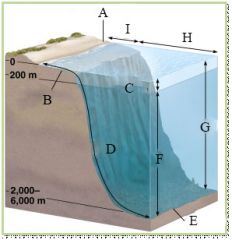
Stratification of marine biomes
|
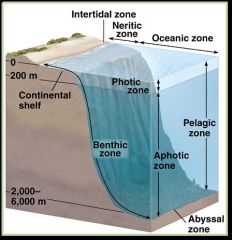
A-I
|
|
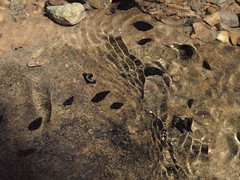
Characteristics of freshwater biomes
|
1. Freshwater biomes= 0.1% salt content
2. 3% of earth's water is freshwater 3. impacted by speed flow (moving or still) 4. Impacts terrestrial biomes |
|
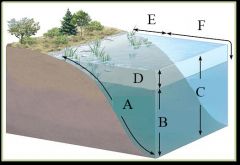
Stratification of freshwater biomes
|

A-E
|
|
|
Characteristics of Terrestrial biomes
|
1. Determined by climate, altitude and latitude
2. Usually named for climate features or predominant living organisms (usually plants) 3. affected by weather patterns (in/consistent) 4. affected by annual mean precipitation 5. Affected by annual mean temp |
|

Stratification of Terrestrial biomes
|

A-E
|
|
|
Clumped dispersion
|
individuals aggregate in group due to nutrients (fungi) or social behavior (wolves)
|
|
|
Uniform dispersal
|
evenly spaced pattern of dispersal due to individual interactions (nesting birds)
|
|
|
Random dispersion
|
Position of each individual is independent of others- no strong attractions or repulsions (dandelions); least common pattern
|
|
|
Intraspecific competition
|
competition for resources btwn individuals of the same spp when resources are in short supply; tends to decrease pop
ex: darwins finches |
|
|
territoriality
|
behavior in which an animal defends a bounded physical space against encroachment by other individuals, usually of the same spp; tends to limit pop
ex: predators (tigers and scent markings) |
|
|
Health
|
an increase in population density results in inc in disease incidence
ex: flu in hum |
|
|
Predation
|
As prey population fluctuates predator predator population fluctuates as well
ex: snow shoe hare and lynx |
|
|
Toxicity
|
An increase in population density results in an increase in toxic metabolic waste
ex: yeast |
|
|
Intrinsic factors
|
An increase in population density result in aggressive behaviors, inc stress while decrease the population
ex: rodents |
|
|
competition exclusive principle
|
when two spp compete for the same limiting resource, one spp will use the resource more efficiently causing the local elimination of the other
1. one spp can either move out, die out , or adapt 2. mechanism for nat selection |
|
|
parasitism
|
interaction between two spp in which one spp (parasite-usually smaller) derives nourishment while the other spp (host-usually larger) is harmed.
ex: head lice |
|
|
Mutualism
|
interaction between two spp in which both benefits
1. coevolution usually occurs between mutualistic spp a. methanogens in herbivores b. N-fixing bacteria in legums c. lichens |
|
|
commensalism
|
interaction between two spp in which one spp benefits and the other is neither harmed nor benefitted
1. ex: sharks and remoras 2. ex: herbivores and cattle egrets |
|
|
Megafauna hypothesis
|
the size of the carnivore places an upper limit on the size of food it can eat
1. large carnivores cannot live on small prey due to their inability to acquire enough prey fast enough to meet their metabolic rate ( the size of the food has to fit the size of the predator |
|
|
Zoonotic disease
|
any infectious disease capable of being transmitted by vertebrate animals (wild/dome) to humans
-involve bacteria, parasite, viruses -over 22 known disease -known for centuries - ex: swine flu, rabies |
|
|
(Primary production) Net primary production
|
gross primary production minus the energy used by producers during respiration
-determined by (primary producers) *size of area covered by primary producers *Efficiency of primary producers |
|
|
(Primary production) Gross primary production
|
total amount of light energy converted into chemical energy by producers during a given amount of time
ex: prokaryotes, algae, green plants |
|
|
(Secondary Production) Secondary production
|
amount of chemical energy converted into biomass by heterotrophs during a given amount of time
ex: browser and gazer |
|
|
Green World Hypothesis
|
predators hold terrestrial herbivores in check, preventing them from consuming excessive amounts of plant biomass (carnivores, parasites, diseases, etc)
-Predators= carnivores, parasites, disease, etc - Herbivores consume less than 17% of total plant biomass |
|
|
Bioaccumulation
|
increasing concentrations of potentially toxic substances in living organisms; easily ingested but not biodegradable
|
|
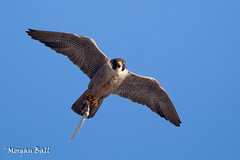
Biomagnification
|
increasing concentrations of potentially toxic substances in food chains; exponentially increasing at each level
|
|
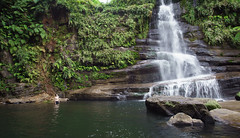
Tropical rainforest
|
-Predominant vegetation: wide variety of plants
-location: equatorial - Temo: Warm - Rainfall: 200-400 cm/yr |
|

Savannas
|
-predominant vegetation: grasses, scattered trees
-locomotion: equatorial-tropics of capricorn - Temp: warm -Rainfall: 30-50 cm/year |
|

Desert
|
-predominant veg: cacti
- location: Tropics of capricorn/Cancer - Temp: hot - Rainfall: <30cm/year |
|
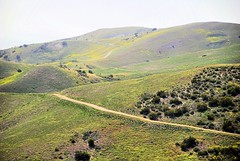
Chaparral
|
-Predominant vegetation: dense, spiny, evergreen shrubs
- location: S tropic of capricorn/N topic of Cancer - Temp: hot summers, mild winters - Rainfall: 25-45 cm/year |
|

Coniferous Forests
|
-Predominant vegetation: conifers
- Location: N tropic of Cancer - Temp: cool - Rainfall: 39-75 cm/year |
|
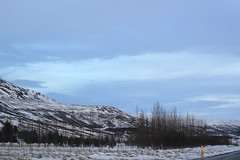
Tundra (the driest)
|
-predominant veg: grasses, mosses, lichens
- Location: Arctic Circle - Temp: cold - Rainfall: 5-25 cm/year |

